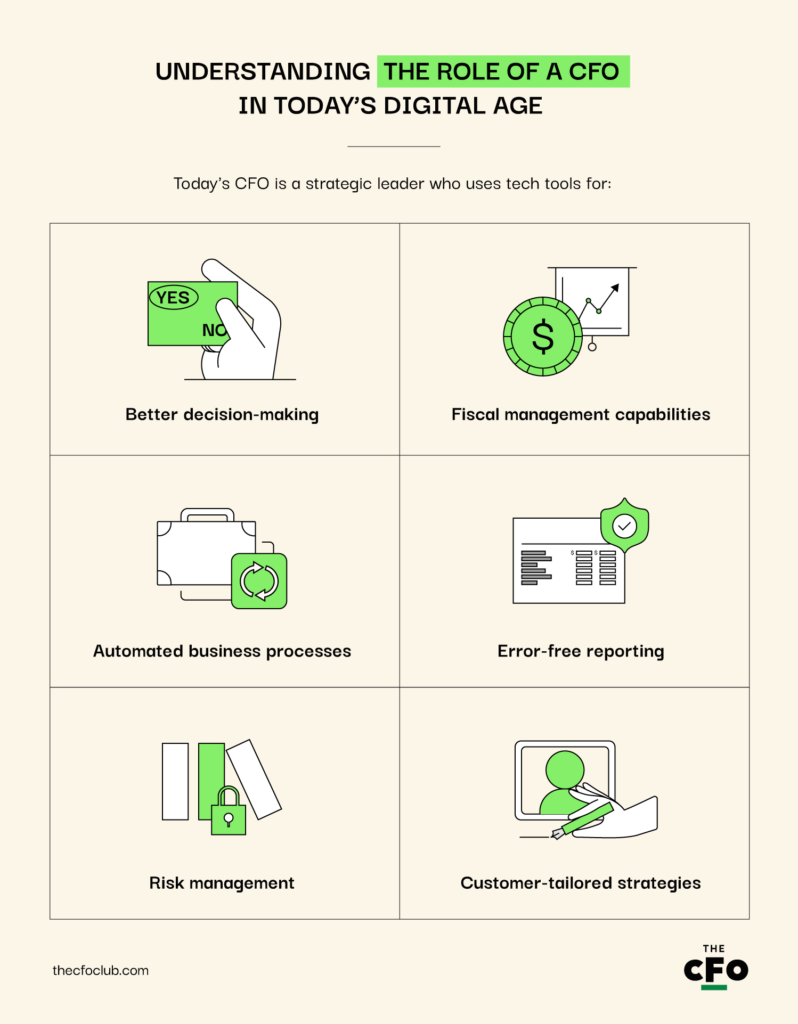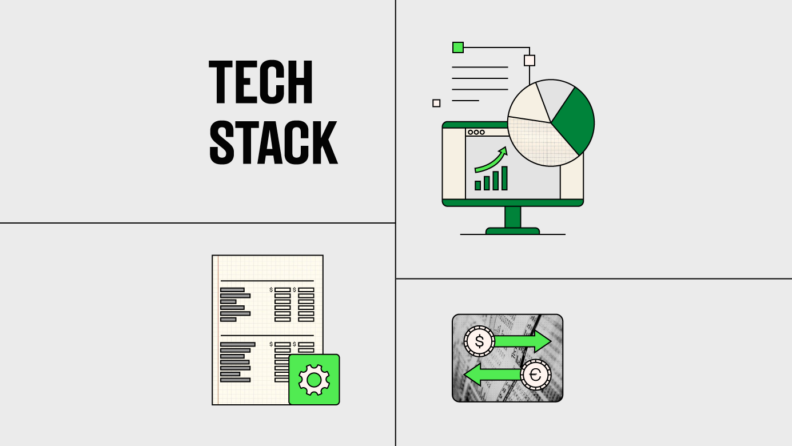It's no secret that the role of a Chief Financial Officer has evolved far beyond number-crunching: You need to make strategic decisions and deliver results.
The key to making the best decisions? Having a trusty tech stack to gather data from.
Here's what you need to know about a CFO tech stack to find the tools that work for you and fine-tune your team's financial performance.
Understanding the Role of a CFO in Today's Digital Age
Today's CFO is a strategic leader who uses tech tools for:
- Better decision-making
- Fiscal management capabilities
- Automated business processes
- Error-free reporting
- Risk management
- Customer-tailored strategies

Digital transformation now permeates every facet of business, and the financial function is no different. From advanced analytics to assess risks to artificial intelligence for process automation—you can get much more done, quicker, by tagging in technology.
The Rise of the Tech-Savvy CFO
One Gartner study found that nearly 50% of all CIOs are planning to deploy AI solutions— considering you’re here, I’m willing to bet you can’t lean back and let the CIO handle things; you need to make these changes yourself.
Deep understanding is required here. It’s about knowing what technologies are available and how they can be leveraged effectively within your organization.
Impact of Tech on Financial Operations
Embedding tech into financial operations allows you to outsource your eyes, letting you spend less time monitoring results and more time using that data in your decision-making.
Imagine this:
- Actual financials are consistently within your margin of error from your budget
- You have real-time insights into how each department is performing
- You can see exactly where your forecasts are going awry, whenever it starts happening
Dreamy, right?
This new era is thrilling… but you’re not quite there yet.
First, you need to select the right tools from an ever-expanding selection. Then, you need to implement them effectively. Finally, you need to get your team on board with utilizing them.
It can be a lot to swallow at once, so let's start by digging deeper into why you need a CFO tech stack.
5 Benefits of Implementing a Robust CFO Tech Stack
It can be hard to convince other executives to invest in your department above their own, so let’s start with some data-backed benefits you can share.
Better Organizational Decision-Making
A good data analysis tool can turn raw numbers into actionable insights, allowing you to keep tabs on how departments, business lines, and locations are doing.
One AICPA article highlights how data analytics can inform executive-level decision-making, shake up workflows, and give companies a competitive edge.
Faster & More Accurate Processes
No one likes repetitive tasks. They're time-consuming and tedious, which leads to more flippant operations… which opens you up to all types of critical errors.
Automation software can replace all types of Excel sheets, freeing up your finance team for more critical work. The result? More productivity and fewer late nights at the office.
Error-Free Reporting
Accounting systems, especially those with built-in AI support, help ensure accuracy in reporting.
They automatically spot errors humans might miss - so say goodbye to those embarrassing typos on your balance sheet.
Proactive Risk Management
Digital tools give real-time snapshots of a company's finances, allowing you to keep tabs on what’s happening without requiring a full business audit.
This capability allows you and your team to act proactively rather than reactively against risks or opportunities. This, in turn, leads to better business outcomes overall.
Create Cohort-Specific Customer Strategies
Once you’ve used your tools to conduct cohort analyses on your customers, you can utilize powerful algorithms and predictive analytics to forecast customer behaviors.
This helps your team create strategies tailored to each cohort, thus increasing the likelihood of each customer spending more with you.
Key Components of a CFO Tech Stack
The CFO tech stack is typically composed of the following software tools; however, you should reflect each one against your active needs to determine whether or not it should be a part of your toolkit.
Accounting Software
I hardly feel like I need to include accounting software, as it’s likely already a part of your tech stack; however, if you aren’t yet using it, that would be number one.
Financial Planning & Analysis Software
FP&A software is the next tool most CFOs implement.
It enables budgeting, forecasting, and planning processes to run smoothly, as you’re able to skip the “create 20 spreadsheets” phase of operations and go straight into analysis.
Data Visualization Tools
CFOs deal with massive amounts of data daily. Therefore, they need data visualization tools that help make sense of it all.
If you aren’t convinced this is important, think about the last time you wanted to communicate financial results to non-financial operators; you had to spend unnecessary time helping them comprehend the magnitude of the numbers you were sharing, right?
Data visualization tools do that for you.
Risk Management Systems
An integrated, well-designed risk management system can be the difference between smooth sailing and an unexpected iceberg.
Rather than keeping you on your toes, guarding against others’ unexpected mistakes, you can allow the tool to keep tabs on what’s going on and communicate it back to you.
Billing & Invoicing Solutions
Efficient billing applications make your life nearly infinitely easier through the automation of invoice creation and real-time payment tracking—like adding a robotic, always-on payments clerk to your team.
Challenges in Building an Effective CFO Tech Stack
Unfortunately, assembling a robust tech stack isn't just about picking the latest and greatest tools. Unexpected issues make innovation a non-starter - but don’t worry, they can be avoided.
Keep an eye out for the following concerns when building your tech stack:
1. Finding Compatible Technologies
Different platforms have unique requirements and interfaces, which means not all technologies play nicely in the sandbox.
When assembling your tech stack, look for your core tools first and ask about integrations upfront. If they’re limited, wait to see what else you may want to add to the portfolio before signing into anything.
90% of the time, a slightly inferior tool that can integrate well with your other tools is going to be a better option.
2. Navigating Rapid Technological Advancements
The last few years have shown us that tech solutions can advance at a breakneck speed… but there’s no need to take it on yourself.
I recommend two strategies for keeping up to date:
- Team up with your favorite tech-enabled executive - like your CTO - and ask them to keep an eye out for new financial tools hitting the market.
- Subscribe to publications like The CFO Club that cover this sort of thing to get passively updated whenever something new hits the market.
3. Budget Constraints
Working with a tight budget? You have two (non-mutually-exclusive) options:
- Get a procurement specialist on the case, asking them to negotiate budgets on your behalf.
- Communicate the potential savings you’ll find by implementing these tools. You’ll want to forecast as accurately as possible here; otherwise, you’re no better than that guy in marketing who swears, “This tool will change the whole company!”.
Getting your hands on high-quality tools at a good price might feel like looking for Waldo at a candy cane convention, but remember to think of the long-term when assessing them.
4. Tech Adoption and Training Hurdles
Sometimes, introducing new tech feels less like progress and more like trying to teach your darling golden retriever how to use TikTok.
Getting team members up-to-speed with new systems often involves overcoming resistance and managing learning curves, necessitating a clear digital transformation roadmap.
Selecting the Right Tools for Your CFO Tech Stack
Before signing off on your finalized tech stack, you need to consider the extraneous elements associated with each platform, such as:
- Scalability: Can your tools grow alongside your team? If not, are you okay with that? Sometimes it’s worth it to use the smaller tools to save money… and sometimes it’s a massive headache waiting to happen. Be clear about which situation this is.
- Flexibility: Conversely, can the tools accommodate a smaller team, either through increased automation or a smaller plan size? Do a bit of risk forecasting for each one.
- Features: Having a million features doesn’t equate to the best solution. Selecting tools that solve your team’s real, stated problems is more important than a fancy dashboard 99% of the time.
- Ease-of-use: Think about how easily/quickly you’ll be able to teach your current and future team members how to use each tool. Someone is going to have to teach them, so consider the labor hours involved with each one.
- Vendor reputation: Conduct some due diligence on the vendor’s reputation. See what others say about the vendor's reliability, level of service, and overall reputation before you leap to a shiny new tech stack. Ask for references.
- Security: Most data breaches notoriously target small organizations, thus, your tech stack has to be secure. This is no longer considered nice-to-have—it’s vital.
Best Practices for Managing and Updating Your Tech
Choosing the tools is a great starting point, but the job doesn’t end there.
Just as hiring an employee doesn’t mean they’ll continue producing forever, you need to manage your tech stack to ensure it’s operating at peak performance. Here are some of the ways you can do it.
Maintain Regular Updates
You wouldn’t expect your phone to be as fast as everyone else’s if you never updated it, would you?
Your work toolset should be thought of the same way. Ensure your software is current with needed new features for both efficiency and security.
User Training
Proper, user-friendly software is a must - before purchasing, get other members of your team - ideally, those who would be using the tool - to try poking around in it. If you love it but they say it’s unusable, you should think twice before buying.
Be Honest About Usage
If you had to fight to get a new tool implemented, I’m willing to bet that you’d rather not admit it if you don’t end up using it; however, by being honest with yourself about what’s actually having an impact on your business, you can free up budget for other tools that could move the needle.
Regularly check in with yourself and your team about software usage to ensure you don’t have latent software licenses eating away at your profits.
Prioritize Security
In finance, security isn't optional—it's mandatory. Invest time and resources into strong encryption methods and firewalls to protect sensitive data from cyber threats, wherever they may come from.
CFO Tech Stack: Thrive In 2024
Preparing for hurdles in 2024 and beyond means streamlining operations, helping make data-driven decisions, and driving growth.
Thriving in 2024 means a robust CFO tech stack is no longer a 'nice-to-have’. It's necessary.
Ready to compound your abilities as a finance leader? Subscribe to our newsletter for expert advice, guides, and insights from finance leaders shaping the tech industry.



